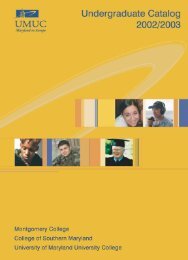UNDERGRADUATE CATALOG - UMUC Europe
UNDERGRADUATE CATALOG - UMUC Europe
UNDERGRADUATE CATALOG - UMUC Europe
You also want an ePaper? Increase the reach of your titles
YUMPU automatically turns print PDFs into web optimized ePapers that Google loves.
CouRsE dEsCRiPtions<br />
biol 101 tHRougH biol 211<br />
biology<br />
Courses in biology (designated BIOL) may be applied as<br />
appropriate, for example, toward:<br />
G the general education requirement in the biological and<br />
physical sciences; and<br />
G electives.<br />
biol 101 Concepts of biology (3)<br />
(For students not majoring in a science.) An introduction<br />
to living things based on physical, chemical, and biological<br />
principles. The organization, processes, interdependence,<br />
and variety of living organisms are explored. Emphasis is on<br />
understanding the impact of biological knowledge on human<br />
societies. Consideration is given to current events that involve<br />
biological systems. Students may receive credit for only one of<br />
the following courses: BIOL 101, BIOL 103, BIOL 105, or<br />
BSCI 105.<br />
biol 102 laboratory in biology (1)<br />
(For students not majoring in a science. Fulfills the laboratory<br />
science requirement only with previous or concurrent credit<br />
for BIOL 101.) Prerequisite or corequisite: BIOL 101. A<br />
laboratory study of the concepts underlying the structure<br />
and functioning of living organisms. Laboratory exercises<br />
emphasize the scientific method and explore topics such<br />
as the chemical foundations of living organisms, pH, cell<br />
structure and function, metabolism, DNA structure and<br />
function, mechanisms and patterns of inheritance, evolution,<br />
classification, and population biology and ecosystems.<br />
Students may receive credit for only one of the following<br />
courses: BIOL 102, BIOL 103, BIOL 105, or BSCI 105.<br />
biol 103 introduction to biology (4)<br />
(Fulfills the laboratory science requirement. Not open to<br />
students who have completed BIOL 101 or BIOL 102.<br />
Laboratory activities are performed both online and at home.<br />
Purchase of a lab kit and various other common household<br />
and food items is required.) An introduction to the concepts<br />
underlying the structure and function of living organisms.<br />
The organization, chemical foundations, metabolism,<br />
genetics, evolution, ecosystems, and interdependence of<br />
living organisms are explored. The scientific method is used<br />
to emphasize these topics through laboratory activities.<br />
Students may receive credit for only one of the following<br />
courses: BIOL 103, BIOL 105, BSCI 105, or BIOL 101 and<br />
BIOL 102.<br />
150<br />
UndERGRAdUATE CATALoG | 2009-2010<br />
biol 160 Human biology (3)<br />
(Science background not required.) A general introduction to<br />
human structure, functions, genetics, evolution, and ecology.<br />
The human organism is examined from the basic cellular<br />
level and genetics, through organ systems, to interaction with<br />
the outside world. Pertinent health topics are also discussed.<br />
Students may receive credit for only one of the following<br />
courses: BIOL 160 or GNSC 160.<br />
biol 161 laboratory in Human biology (1)<br />
(Fulfills the laboratory science requirement only with<br />
previous or concurrent credit for BIOL 160.) Prerequisite<br />
or corequisite: BIOL 160. A laboratory course that uses the<br />
human organism as an example to illustrate the concepts<br />
underlying the organization and interrelationships of all living<br />
organisms.<br />
biol 201 Human Anatomy and Physiology i (4)<br />
(Fulfills the laboratory science requirement.) Prerequisite:<br />
BIOL 101, BIOL 103, BIOL 105, BIOL 160, or BSCI 105.<br />
A thorough introduction to the anatomy and physiology of<br />
the integumentary, skeletal, muscular, and nervous systems of<br />
human beings. An overview of cellular physiology is included.<br />
Students may receive credit for only one of the following<br />
courses: BIOL 201 or ZOOL 201.<br />
biol 202 Human Anatomy and Physiology ii (4)<br />
(Fulfills the laboratory science requirement.) Prerequisite:<br />
BIOL 101, BIOL 103, BIOL 105, BIOL 160, or BSCI 105.<br />
An introduction to the anatomy and physiology of the<br />
sensory, cardiovascular, endocrine, lymphatic, respiratory,<br />
digestive, excretory, immune, and reproductive systems.<br />
Intermediary metabolism and endocrine relationships are<br />
also studied. Students may receive credit for only one of the<br />
following courses: BIOL 202 or ZOOL 202.<br />
biol 211 Environmental science (3)<br />
A survey of ecological principles as they apply to the<br />
interrelated dilemmas of sustainability. Topics include<br />
overpopulation, pollution, over-consumption of natural<br />
resources, and the ethics of land use. Students may receive<br />
credit for only one of the following courses: BIOL 211,<br />
BOTN 211, or PBIO 235.






